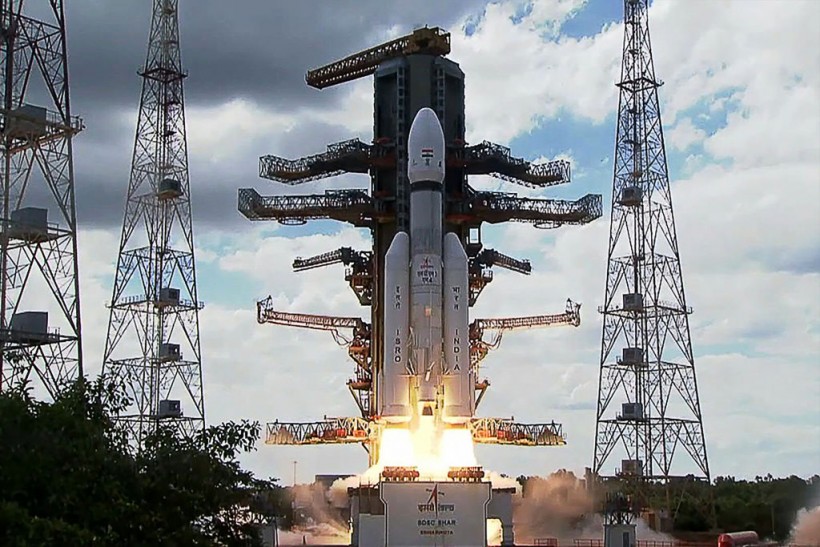The Chandrayaan-3 mission of the Indian Space Research Organization (ISRO) was successfully launched on Friday from the Satish Dhawan Space Centre.

TOPSHOT - This screen grab made from video footage from ISRO via AFPTV taken on July 14, 2023, shows an Indian Space Research Organisation (ISRO) rocket carrying the Chandrayaan-3 spacecraft lifting off from the Satish Dhawan Space Centre in Sriharikota, an island off the coast of southern Andhra Pradesh state. On July 14, India launched a rocket seeking to land an unmanned spacecraft on the surface of the Moon, a live feed showed, its second attempt to become only the fourth country to do so.
Chandrayaan-3 Mission Successfully Launches
The Register reports that the LVM3 launch of the ISRO holds a rover and lander and is bringing them to a lunar orbit of 100 kilometers. The ISRO confirmed on Friday that the craft is in a precise orbit, has started journeying to the lunar satellite, and is in normal health. It will take 42 days to travel toward the Moon.
After this period, the spacecraft will land close to the lunar south pole. It will then spend the next 14 Earth days conducting various experiments.
If this mission succeeds, CNN explains that India would be the fourth nation to conduct a controlled lunar landing. The country would only fall behind China, the USSR, and the USA.
According to Sky and Telescope, the mission aims to land on the near side of the Moon, close to the Mutus Crater situated at the south pole. This area is expected to have prehistoric ejecta and lunar crust from early periods of strong bombardment during the solar system's early history. The landing attempt timing also matches the sunrise on the Moon. This is timed so that the images of the craft will be granted maximum survival time and terrain contrast for the rover and lander to examine their surroundings.
Interestingly, the mission is working with a massive budget that goes as high as $74.5 million.
ALSO READ: Indian Space Research Organization (ISRO) Set To Launch Lunar Lander Chandrayaan-3 Next Week
Previous Chandrayaan Missions
Sky and Telescope add that this Chandrayaan-3 mission follows its predecessor, the Chandrayaan-2, launched in 2019. During this leg, an orbit was successfully placed around the Moon. However, the lander crashed into the Moon's surface due to a software glitch.
Before this, there was the 2008 Chandrayaan-1 mission. During this leg, the Chandrayaan-1 impact probe reached the lunar surface.
A Better Version
Chandrayaan-3 incorporates some vital lessons learned from the previous Chandrayaan-2 mission, especially. As such, the craft now boasts stronger legs, more cameras for descent coordination, and other kinds of features.
It also has a Spectro-polarimetry of Habitable Planet Earth (SHAPE) equipment in the propulsion module. This instrument does not only examine the Earth but can also look for habitable exoplanets. This propulsion module will remain in orbit and serve as a satellite for communications for the rover and lander.
Nevertheless, similar to the Chandrayaan-2, the Chandrayaan-3 also has a Vikram lander, an orbital booster, and the tiny 26-kilogram Pragyan rover.
The landing site of the Chandrayaan-3 will be roughly 100 kilometers away from where the Cahndrayaan-2 previously crashed.
The new mission mainly follows the aims of the earlier mission, which were to showcase landings and operational capacity over the lunar surface. It may also be able to find evidence of water ice close to the poles, which the mission's first leg was able to discover during orbit back in 2009.
RELATED ARTICLE: Potential Landing Area for Artemis III Mission: Moon Mountain Named After NASA Computer Programmer, Towering as Tall as North America's Highest Peak
Check out more news and information on Space in Science Times.



![Earth's Quasi-Moon Kamo‘oalewa Could Originate From Lunar Surface Not Asteroid Belt [Study]](https://1721181113.rsc.cdn77.org/data/thumbs/full/53275/89/56/50/40/earths-quasi-moon-kamo-oalewa-could-originate-from-lunar-surface-not-asteroid-belt-study.png)










